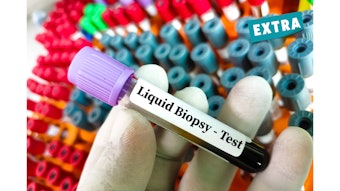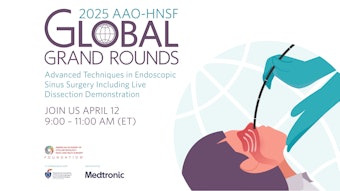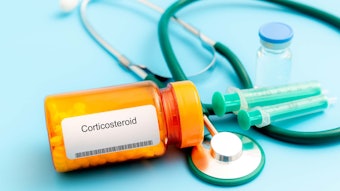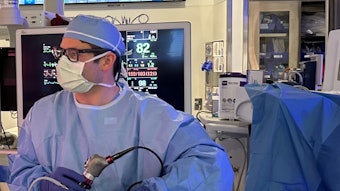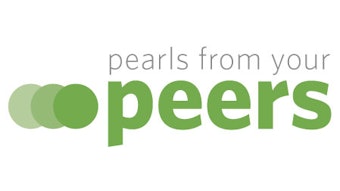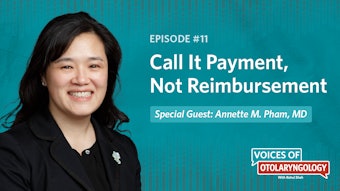What Is Laryngeal Dystonia?
Laryngeal dystonia, a condition causing intermittent contractions of the larynx muscles, is believed to be a central neurological disorder involving a multiregional altered neural network.
Mark R. Gilbert, MD, Mausumi N. Syamal, MD, and Anca M. Barbu, MD, on behalf of the Voice Committee

LD is classified into several types: adductor dystonia (ADLD), which is most common, abductor dystonia (ABLD), singer’s LD (SLD), and adductor respiratory (ARLD). ADLD presents as a harsh, tight, strained or strangled voice on vowels, while ABLD presents commonly with breathy breaks on voiceless consonants. LDs can also occur with or without voice tremor.
Although much about the condition remains to be explained, LD is believed to be a central neurological disorder involving a multiregional altered neural network.2 Functional magnetic resonance imaging studies have shown distinct alterations within the sensorimotor network, and LD patients with a family history have distinct cortical and cerebellar abnormalities.3 Abnormal activation and intensity in the primary somatosensory cortex have also been associated with LD.4
The disorder is considered rare and affects as many as 35.1 per 100,000 individuals in the general population. LD is seen predominantly in women (4:1 ratio).1 The mean age of onset is mid-life, between 45 and 55 years, and may be gradual or sudden.
How Is LD Diagnosed?
What makes LD an unusual voice disorder is the lack of stroboscopic or laryngoscopic parameters that are specific for it. Rather, LD is diagnosed by auditory-perceptual voice evaluation when completing speech-specific tasks. It may be difficult to distinguish LD from either a vocal tremor or muscle-tension dysphonia. The possibility of overlap among these diagnoses makes this task highly challenging, even for experienced otolaryngologists and speech-language pathologists. However, there are hallmarks of LD that tend to make the condition rather distinct1.
Adductor dystonias are distinguished by adductory spasms during phoneme-specific tasks of connected vowels with voiced consonants (e.g., “We were away a year ago”).
Abductor dystonias, in contrast, involve sudden breathy breaks in sound with phoneme-specific tasks of voiceless consonants followed by vowels (e.g., “Pay Paul a penny”) where the consonant-to-vowel connection is disrupted.
Both adductor and abductor dystonias are absent with falsetto or head voice, singing, or whispering, and may worsen with stress or improve with alcohol. Variants of these disorders exist, such as the chronic constriction variant of ADLD, that may appear like muscle tension dysphonia but may be distinguished by the absence of strain in tasks like singing.
Singing dystonias are even rarer and essentially present with strain or strangulation or breathy features but only with singing. This condition can be especially challenging for professional vocalists.5
Vocal tremor, a neurologic phenomenon, presents with rhythmic pulsations of pitch and loudness with sustained phonation and is not dependent on phonemes. When muscle tension is present with tremor, it can be hard to distinguish from dystonia to the inexperienced ear.
What Are the Current Treatments for LD?
The current gold standard treatment of LD is the injection of botulinum toxin A (BoNT), which acts by cleaving a SNARE protein, SNAP-25, in the presynaptic terminal of the neuromuscular junction.6 SNAP-25 is required to fuse vesicles containing acetylcholine with the terminal wall. When it is cleaved, they are unable to release the neurotransmitter and cause transmission to the postsynaptic terminal. Dosage adjustments can cause ranges of paresis to paralysis of the muscle. Initially, the presynaptic terminal produces new nerve sprouts that release acetylcholine, followed by a second phase in which normal function is restored, and the sprouts are removed. BoNT typically lasts months exerting this effect. It should be noted that despite being the gold standard, BoNT is an off-label treatment for LD, and this may affect CMS and private insurance coverage.
As the dosages are typically quite low—on the order of a few units per side of the larynx—many providers will use a vial for multiple patients, though this can be highly variable based on insurance company regulations and the institution and typical practice.7,8
BoNT injections may be placed into the various involved laryngeal muscle groups (e.g., thyroarytenoid/lateral cricoarytenoid or posterior cricoarytenoid) and may be accomplished via EMG guidance, flexible laryngoscopic guidance, or even via direct microlaryngoscopy, according to the practitioner’s preference. Indirect injections into the false vocal folds have also been described; these act by dissipating slowly into the adductory laryngeal muscles.9
Are There Any New Treatments Being Investigated for LD?
Given that BoNT injection offers only short-term benefit and is predominantly effective for ADLD versus other forms of LD, researchers are exploring other treatment pathways. Surgical treatments for LD have been offered in the form of selective laryngeal denervation-reinnervation, type 2 thyroplasty with an implant, and endoscopic laser myomectomy of the thyroarytenoid or posterior cricoarytenoid muscles.10
Pharmacological pathways for alcohol-responsive LD are also being investigated. Sodium oxybate is a centrally acting oral drug that has been used in an open-label study with LD patients. Although sodium oxybate is a schedule III-controlled substance that crosses the blood-brain barrier, it was found to significantly reduce symptom severity in the majority (82.2%) of patients with alcohol-responsive LD and can have beneficial effects lasting about four hours.11 Currently, Simonyan and colleagues at the Massachusetts Eye and Ear Infirmary are leading a double-anonymized, placebo-controlled randomized crossover study of sodium oxybate. They aim to gain a more in-depth understanding of the benefits of this drug and whether it can be recommended as a treatment option for alcohol-responsive LD.12
References
- Simonyan K, Barkmeier-Kraemer J, Blitzer A, Hallett M, Houde JF, Jacobson Kimberley T, Ozelius LJ, Pitman MJ, Richardson RM, Sharma N, Tanner K; The NIH/NIDCD Workshop on Research Priorities in Spasmodic Dysphonia/Laryngeal Dystonia. Laryngeal Dystonia: Multidisciplinary Update on Terminology, Pathophysiology, and Research Priorities. Neurology. 2021 May 25;96(21):989-1001. doi: 10.1212/WNL.0000000000011922. Epub 2021 Apr 15. PMID: 33858994; PMCID: PMC8205448.
- Lee CW, Krüger MT, Akram H, Zrinzo L, Rubin J, Birchall MA, Fishman JM. Central Mechanisms and Pathophysiology of Laryngeal Dystonia: An Up-to-Date Review. J Voice. 2024 Aug 12:S0892-1997(24)00217-0. doi: 10.1016/j.jvoice.2024.07.007. Epub ahead of print. PMID: 39138040.
- Blitzer A, Brin MF, Simonyan K, Ozelius LJ, Frucht SJ. Phenomenology, genetics, and CNS network abnormalities in laryngeal dystonia: A 30-year experience. Laryngoscope. 2018 Jan;128 Suppl 1(Suppl 1):S1-S9. doi: 10.1002/lary.27003. Epub 2017 Dec 8. PMID: 29219190; PMCID: PMC5757628.
- Simonyan K, Ludlow CL. Abnormal activation of the primary somatosensory cortex in spasmodic dysphonia: an fMRI study. Cereb Cortex. 2010 Nov;20(11):2749-59. doi: 10.1093/cercor/bhq023. Epub 2010 Mar 1. PMID: 20194686
- Chitkara A, Meyer T, Keidar A, Blitzer A. Singer's dystonia: first report of a variant of spasmodic dysphonia. Ann Otol Rhinol Laryngol. 2006 Feb;115(2):89-92. doi: 10.1177/000348940611500201. PMID: 16514788.
- Brin MF, Burstein R. Botox (onabotulinumtoxinA) mechanism of action. Medicine (Baltimore). 2023 Jul 1;102(S1):e32372. doi: 10.1097/MD.0000000000032372. PMID: 37499078; PMCID: PMC10374191.
- Barrow EM, Rosen CA, Hapner ER, Smith S, Hatcher JL, Simpson B, Johns MM 3rd. Safety and efficacy of multiuse botulinum toxin vials for intralaryngeal injection. Laryngoscope. 2015 May;125(5):1149-54. doi: 10.1002/lary.25068. Epub 2014 Dec 4. PMID: 25476036.
- Gilbert MR, Young VN, Smith LJ, Rosen CA. Multidose Botulinum Toxin A for Intralaryngeal Injection: A Cost Analysis. J Voice. 2019 Mar;33(2):159-161. doi: 10.1016/j.jvoice.2017.11.004. Epub 2018 Jan 4. PMID: 29307768.
- Simpson CB, Lee CT, Hatcher JL, Michalek J. Botulinum toxin treatment of false vocal folds in adductor spasmodic dysphonia: Functional outcomes. Laryngoscope. 2016 Jan;126(1):118-21. doi: 10.1002/lary.25515. Epub 2015 Oct 15. PMID: 26467807.
- Blitzer A, Brin MF, Simonyan K, Ozelius LJ, Frucht SJ. Phenomenology, genetics, and CNS network abnormalities in laryngeal dystonia: a 30-year experience. Laryngoscope 2018;128(Suppl 1):S1–S9
- Rumbach AF, Blitzer A, Frucht SJ, Simonyan K. An open-label study of sodium oxybate in spasmodic dysphonia. Laryngoscope 2017;127:1402–1407.
- https://clinicaltrials.gov/study/NCT03292458?a=15


